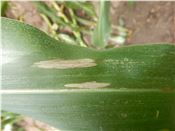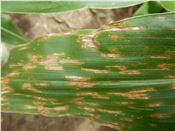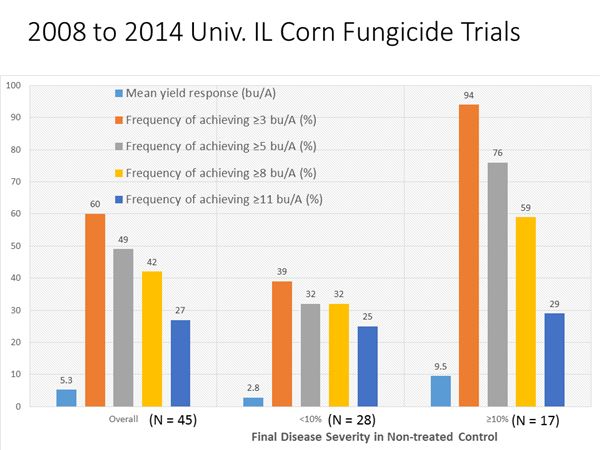Corn Disease Update And Farewell
DR. CARL BRADLEY
URBANA, ILL.
Last week, I visited all of the University of Illinois corn variety trials in the northern half of the state. Gray leaf spot and northern leaf blight were beginning to appear in most of the locations, but were the most obvious at the trial located near Perry, IL (Pike County).
With the amount of rainfall received in the past few weeks, it is not surprising that these diseases were beginning to appear. Since hybrids differ in their level of susceptibility to these diseases, not all hybrids in the trials had symptoms. If the rainy conditions continue, then a foliar fungicide application sometime between tassel emergence and silking may need to be considered on hybrids that are the most susceptible. Some general guidelines that may help make a foliar fungicide application decision follow:
• On susceptible to moderately-susceptible hybrids: consider a foliar fungicide if disease is present on the third leaf below the ear or higher on 50 percent of the plants prior to tasseling.
• On intermediate hybrids: consider a foliar fungicide if the field has a history of disease, if the previous crop was corn with at least 35 percent of the ground covered with residue, if disease is present on the third leaf below the ear or higher on 50 percent of the plants prior to tasseling, and if warm and humid weather has persisted.
• On moderately-resistant to resistant hybrids: foliar fungicides generally are not recommended, but scouting is important to confirm that diseases are not present.
The presence of diseases does make a difference in how profitable a fungicide application may or may not be. From trials conducted at the University of Illinois from 2008 to 2014 at many environments (45 total environments) in Illinois, the results indicate that the overall yield response to foliar fungicides was 5.3 bushels/acre (see chart below). However, this yield response was 9.5 bushels per acre when disease developed to affect at least 10 percent of the leaf area in untreated controls (in 17 of the environments). In situations with low disease severity (disease developed to less than 10 percent of the leaf area in untreated controls), the average yield response was only 2.8 bushels per acre (in 28 of the environments). Obviously, the marketing price of corn and the fungicide and application costs will determine if fungicide applications were profitable. The chart below shows the profitability of fungicide applications under different yield response goals (3, 5, 8, and 11 bushels per acre). The bottom line is that it takes a higher yield response to be profitable when corn marketing prices are lower.
On a final note, my last day at the University of Illinois was (June 30). I will be moving to a similar position at the University of Kentucky, and will be based out of the Princeton Research and Education Center in the western part of Kentucky. I want to thank the University of Illinois for my opportunities here and thank many of you for your support and interest. There are no current plans to replace my position as Extension Plant Pathologist at the University of Illinois. If you have field crop disease questions, the following contacts may be useful:
• University of Illinois Plant Clinic
Email: plantclinic@illinois.edu
• Commercial Agriculture Extension Educators:
• Robert Bellm
Email: rcbellm@illinois.edu
• Dennis Bowman
Email: ndbowman@illinois.edu
• Russ Higgins
Email: rahiggin@illinois.edu
• Angie Peltier
Email: apeltier@illinois.edu ∆
DR. CARL BRADLEY: Extension Plant Pathologist, University of Illinois
 “Young” lesions of northern leaf blight beginning to develop on a corn leaf.
“Young” lesions of northern leaf blight beginning to develop on a corn leaf.

Gray leaf spot lesions developing on a corn leaf.

Results from University of Illinois corn fungicide trials conducted from 2008 to 2014.
All applications were made at tassel emergence (VT).